These Aren't Your Grandparents' Wheelchairs
Rugby wheelchair manufacturer increases productivity 30 to 50%, improves quality by switching to inverter-based welder with advanced waveform technology.
Although it’s called “wheelchair rugby” or “quad rugby”— it’s played by paraplegic athletes in wheelchairs—neither term really captures the sport’s speed or intensity as does its original name: Murderball.
Nor do the athletes fit the stereotypical image of paraplegics, and their chairs bear only a passing resemblance to standard wheelchairs. This, as you might have guessed from the “murderball” name, is a tough sport. The rugby chairs are specialized equipment, designed to withstand full-speed, violent collisions; some are designed with special pickers in the front to hook an opponent’s wheelchair, which is, in turn, designed to stop that from occurring.
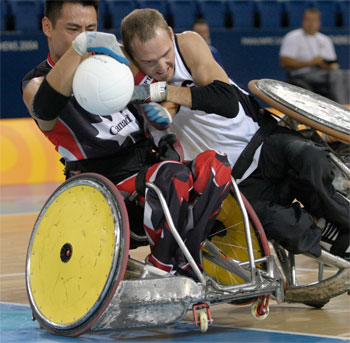 |
What started as a form of recreation and rehabilitation quickly turned into a Paralympic sport.
|
It is a highly competitive sport and each athlete wants the lightest, toughest and fastest chair available. Only a few manufacturers have risen to meet the increasing demand for rugby chairs; of these, Vesco Metal Craft (VMC) is arguably the leader—10 of the 12 players on the U.S. National Team compete in a VMC rugby chair.
VMC is a relatively small company with an enviable reputation for delivering high quality products. It’s owned and operated by Neil Vesco, his father, Tom Vesco, and Paul Richardson. Neil does the welding, as well as fabricating the wings and pickers, and uses his expertise as a mechanical engineer to design and evaluate new products for the company.Until recently, Tom did all of the chair fit up. Now with a new fabricator on board, Tom splits his time between fit-up and final assembly. Paul Richardson, a quad rugby competitor himself, handles customer service.
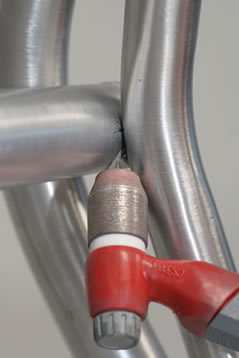 |
With the Dynasty 350’s ability to tightly focus its arc, Neil Vesco can now weld in previously unreachable places.
|
Although an everyday wheelchair could be used, it is doubtful whether anything other than a rugby chair could withstand the punishment dished out in a wheelchair rugby game. Made from 6061 seamless drawn aluminum tubing, which is heat treated to T-6 condition after welding, VMC chairs are lightweight, custom-made to an individual athlete’s requirements. They’re designed to take a beating.
“There are chairs out there that are five years old and that are beat up almost beyond recognition, but you can tell by looking at the welds that they’re our chairs,” says Neil. “The first thing 90 percent of our customers notice when they first see one of our chairs is how phenomenal the welds are. That’s one thing that makes our chairs stand out.”
Making those welds recently got easier and faster. Since switching to Miller Dynasty 350 AC/DC TIG inverters and the advanced waveform control they offer, VMC has been able to decrease welding time by 30-50 percent, while further improving the appearance, strength and weight of their chairs—VMC can now use lighter material and weld in places that previously went unwelded. They are now catching up on back orders and looking toward developing other products, such as “everyday” wheelchairs, for people with disabilities.
The Chairs
VMC makes offensive, defensive, and mid-point (a chair that has a little of both offensive and defensive features) rugby chairs. As mentioned, a defensive chair features pickers to grab an offensive player’s chair, which in turn has wings to block the pickers (see photos).
Each chair is custom-made to suit the individual player’s seat (or dump) angle, rear seat height, the front seat height, the seat width, the seat depth, the inside wheel clearance, the camber angle of the wheels, the frame length, footrest position and the picker style.
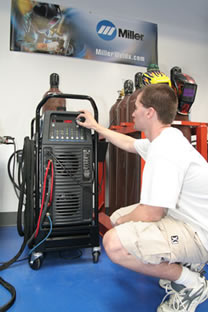 |
On the Dynasty 350, Neil Vesco can quickly dial in the wave form, balance and frequency to match his aluminum welding requirements.
|
To be legal for competition, chairs must meet specifications set by the International Wheelchair Rugby Federation. Initially, VMC frequently changed the design of their chairs to keep up with changes in the sport and to find better ways to decrease weight.
“For the first two years, I don’t think we ever put out more than five chairs where we didn’t make another change,” Neil said. “The sport evolved quickly. The faster the guys got, the better they got and the more they’re abusing the chairs and occasionally cracking them. Chair components needed to be improvised constantly—gussets here and there. It got to the point where we were adding so many gussets and tubes, trying to make them strong enough, but they were still cracking and were getting too heavy.”
It seemed they would have to trade speed for weight to withstand the rigors of the sport. There were two reasons for that. Initially they used .095 wall tubes, and the cracks, when they occurred, were in the heat-affected zone (HAZ), so they switched to.120 wall tube. This helped minimize cracking but added detrimental weight to the chairs.
Also, the limitations of the their conventional technology TIG unit would not allow Neil to weld in all the spots he felt he needed to. Those spots could be a source of failure.
To resolve these issues, two solutions were explored. First, Tom decided to try heat treating the aluminum. Then, Don Peterson from Miller Electric recommended a Dynasty 350® AC/DC TIG inverter and arranged for a VMC to try a test unit. Both steps had immediate benefits.
“Since we began heat treating, we haven’t had one break in the HAZ, and we were able to change the wall thickness from .120 to .083, which reduced the weight from 38 to 35 lbs,” Neil said. “For someone with limited dexterity and muscle movement, that’s a substantial change. The player can definitely feel it.”
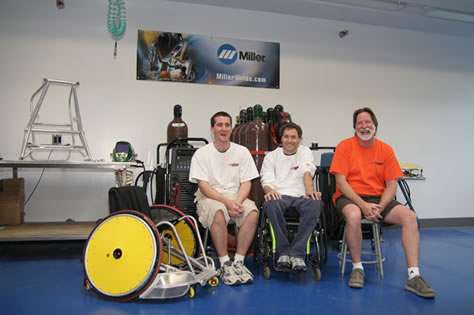 |
Neil Vesco, Paul Richardson and Tom Vesco produce the most popular brand of rugby chairs available. With the recent increase in productivity, their company will be able to start producing everyday chairs.
|
Vesco now sends a batch of four chairs at a time to a local company to be heat-treated. The frames are gusseted and put in fixtures to maintain the specifications. They are then heated to 985 degrees F for 45 minutes and then dropped into a glycol solution to rapidly bring the temperature down. At that time they’re in a T-0 state and easy to tweak, so the frames are then straightened and aligned. Lastly they are put in another oven at 350 degrees F for 8 hours to bring them to a T-6 condition.
Peterson’s suggestion, the Miller Dynasty 350 field-test unit, worked so well that, “We’re not giving it back,” said Tom, who has since then bought a second one. The Dynasty 350 is an AC/DC TIG inverter that features independent amplitude/amperage control, extended balance control, AC frequency control and AC waveforms control (advance squarewave, soft squarewave, sine wave, and triangular wave). These features allow the operator to tailor the arc to his specific job requirements and preferences.
 |
“The diversity of the [Dynasty 350’s] different waveforms… is what makes it ideal as far as we’re concerned,” says Neil.
|
By switching to the Dynasty 350, the company increased productivity by 30 to 50 percent. Since VMC manufactures three to four chairs per week, each requiring a substantial amount of welding, this increase meant producing an additional chair and a half to two chairs per week, while also improving the quality and appearance of the weld.
“The Dynasty 350 welds phenomenally,” says Neil, who was immediately productive with the new unit. “The diversity of the different waveforms¾from welding thick aluminum with a regular advanced squarewave to welding thin aluminum with the triangular wave¾ is what makes it ideal as far as we’re concerned. Then add in the ability to set EN and EP current independently, along with the ability to vary the AC frequency between 20 – 400 HZ , and we get better looking, deeper penetrating welds than ever before. We’re finding that, regardless of how we set it up, it welds just phenomenally.”
Because of Aluminum’s unique properties, such as its excellent thermal conductivity coupled with a low melting point, the Dynasty 350’s ability to precisely control heat led to significant savings.
“With our previous unit, the colder the material, the more heat you had to put into it initially,” Neil says. “Developing the weld puddle was time consuming.”
Then Neil tried the Dynasty 350.
“When we first got the Dynasty 350, it was still set with the factory settings, and it welded better than any machine I’ve ever used. Then I found out how much I could actually change the characteristics of the arc, which really surprised me. It actually got better than where it started. By turning the frequency up and the balance down, we’re able to get a deeper penetrating weld and put much less heat into the frames.”
 |
|
Neil Vesco’s welds are like a signature on every VMC chair. Most of VMC’s customers comment on the high quality.
|
Neil put the Dynasty through its paces, using it on an aluminum bicycle that needed repair.
“I had never welded anything that thin (.030-in.), but the Dynasty 350’s triangular wave provided such a focused arc that’s so easy to control, even on material that thin. I don’t have to worry about the heat absorption of the material. I can just strike an arc and immediately get a weld pool going and continue without a lot of heat being absorbed in the material.”
Additional time is saved because switching tungsten, either because of balling or for different weld requirements, has also virtually disappeared.
“With the Dynasty [350], I weld everything with a 1/8-in. electrode,” says Neil. “I can use it on everything from .065 tubing all the way up to the ¼-in. plate on the front of the chair. To make the welds aesthetically pleasing and structurally sound with our previous unit, I had to match the tungsten to the weld, which required a lot of tungsten changing. Our [previous machine] demanded you use as small as a 1/16-in. electrode.”
Additionally, the electrodes last much longer on the Dynasty 350. Previously, Neil would have to dress them frequently because at 230 amps, the tungsten would start melting, leading to balling and a large dispersion arc.
“On our old machine, the cleaning action (EP) was so poor that you had to turn the balance down to get proper cleaning. Then you could no longer maintain the correct electrode geometry,” says Neil. “Now, I don’t have to dress the electrode due to balling. You can actually maintain a sharp point on the electrode with the Dynasty 350.”
The Dynasty 350’s ability to maintain a sharp electrode and concentrated arc also allows Neil to weld in corners he previously could not unless he extended the electrode outside the shielding gas, which exposed the weld to contamination.
“Now, I can keep the tungsten back in the cup and still get the arc way back in the corners where I wasn’t able to get them before. Previously those spots went unwelded and could be a source of cracking.”
The weld quality is a continuing source of pride for VMC. “All of our customers call to congratulate us on how good the frame looks,” Neil says. (See photo) “I would say the first thing they say when they see the chairs is how phenomenal the welds are. We set a new standard on the market and our chairs are substantially better crafted than the next guy’s out there. The welds are phenomenal on our chairs, and that’s one thing that stands out.”
With the increased productivity, improved weld quality and lower power costs, the VMC team sees the Miller Dynasty as having a huge impact on their business.
“Because all of our jobs depend on everyone else getting their jobs done, if I can get in here and weld more chairs for the week, then everyone else has something to do the following week,” says Neil. “If I don’t get my job done in time, Tom can’t do his and Paul can’t do his.”
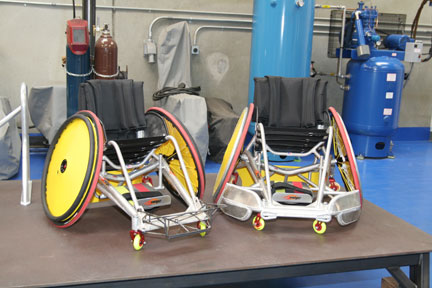 |
A defensive and offensive chair side by side. Notice the different configurations on the front of the chairs.
|
This time savings has allowed VMC to catch up with their backorders for the first time, freeing up time to devote to R&D into other products for people with disabilities. They are now also able to expand their operation with the addition of another trained welder. Finding someone highly skilled in aluminum TIG welding can be difficult, but the Dynasty 350 even made that easier.
“You pick up the Dynasty 350 and you can weld right away,” says Neil. “The person we just hired sat down and welded with the Dynasty and smiled from ear to ear. He got up and said, ‘I can’t believe how well that welder works. I can make any weld look good on that thing.’ And the truth of the matter is, you can. Unless you just started welding today, you can put down a phenomenal bead with that thing.”
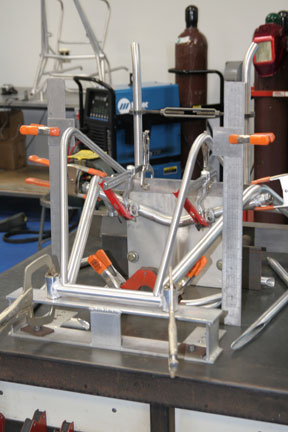 |
Vesco chairs are placed in a jig to ensure they stay true during the tacking process.
|
Assuming a rate of a skilled aluminum TIG welder at $30 an hour, a company saving 30 to 50 percent in welding time would save $1,600-$2,400 in welding time alone, paying for a Dynasty 350 in 2-5 months. (A Dynasty 350 list for about $6,500; with a TIGRunner kit, which includes a cooling system and cart, it lists for about $8,300).
Neil estimates that VMC’s Dynasty 350 has paid for itself in the first month-and-a-half of operation, through increased productivity and decreased energy bills. With its low power draw (26 A at 230 V three-phase for a 250 A, 30V 100 percent duty cycle), the Dynasty 350 is much more efficient than the company’s previous single-phase unit.
The Dynasty 350 delivers 5-350 A (300 A at 32 V 60% duty cycle), enough power to weld ¾-in. thick aluminum and features Miller’s unique Auto-Line power management technology, which allows it to run from any input power, 208-575 V, 1- or 3-phase.
“With the previous unit, I used to watch how fast the meter would turn when he’d start welding and it looked like a fan spinning,” Tom said. “Now power consumption is so low, it’s ridiculous. I know Neil likes the way the machine works, but I like the power factor. It’s a major, major difference in what we’re saving on power.”
But even more than the power, Tom likes the increased productivity and what it means to VMC’s future.
“Now we have time to do other things,” says Tom. “If we’re constantly trying to keep up with orders for rugby chairs, we really can’t grow and expand. Now we can devote some time to R&D for other products. The Dynasty 350 has freed up time to do that.”